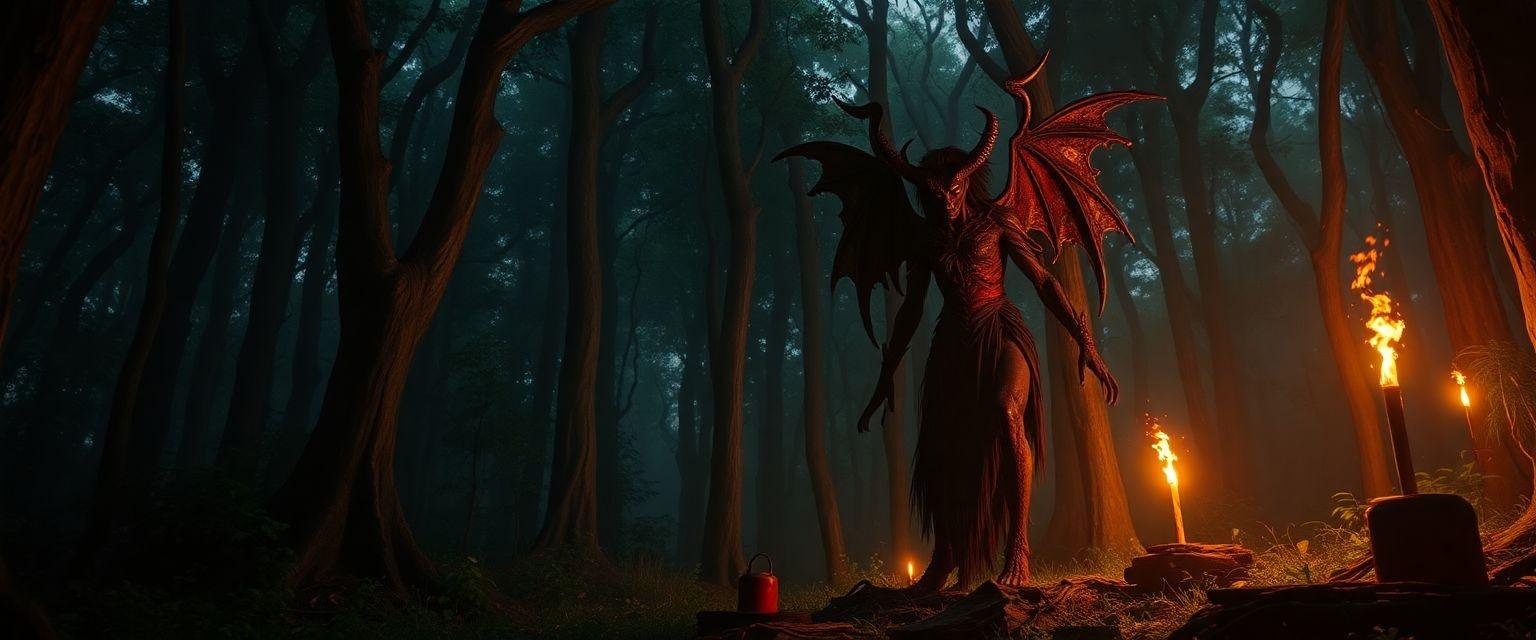10 Terrifying Demons From Folklore
Have you ever wondered what creatures lurk in the shadows of the world’s ancient stories? Across continents and cultures, terrifying demons have haunted the folklore of many societies, each with unique characteristics that reflect the fears and values of the people who tell their stories. From shapeshifters and seductresses to spirits who devour souls, these entities are more than just figments of imaginationthey are cultural symbols. So, what do these demons tell us about the cultures from which they originate? Let’s dive into the world of demon folklore from around the world and explore ten of the most terrifying demons that continue to haunt our imaginations.
Explore Global Demon Folklore
Discover the chilling tales of demons from various cultures and what makes each unique.
– The Churels: A vengeful spirit from South Asian folklore, believed to be the ghost of a woman who died during childbirth.
– The Aswang: A shapeshifting monster from the Philippines that preys on the living, often taking the form of a human by day.
– The Wendigo: A malevolent spirit from Native American legend, associated with winter and starvation, known for its insatiable hunger for human flesh.
1. The Churels
Originating from South Asian folklore, the Churel is a particularly chilling figure. Often depicted as the spirit of a woman who died during childbirth or due to suffering at the hands of her in-laws, she returns as a vengeful spirit. The Churel is known for her ability to shapeshift, usually appearing as a beautiful woman to lure her victims before revealing her true, hideous form.

The Churel serves as a cautionary tale about the treatment of women and the consequences of societal pressures. Would you expect a spirit to take revenge for the injustices it suffered in life? In a society where maternal mortality was high, the Churel represented both fear of the unknown and a warning against mistreating women.
Insider Tip: According to Dr. Anjali Kumar, a folklore expert, the Churel is often used in stories to emphasize the importance of respecting women, suggesting that supernatural tales can serve as powerful societal reminders.
Want to learn more about the Churel’s origins? Check out this detailed exploration of the Churel.
2. The Aswang
The Aswang is one of the most feared creatures in Filipino folklore, often described as a combination of vampire and witch. What makes the Aswang so terrifying is its ability to transform into various animals, making it nearly impossible to detect.

The Aswang preys on the helpless, particularly targeting pregnant women and children. How does the fear of losing the most vulnerable among us shape the stories we tell? For the people of the Philippines, the Aswang is not just a monster; it represents the dangers lurking in the jungle, where the line between the natural and supernatural is blurred.
Insider Tip: Dr. Maria Santos, a cultural historian, suggests that the Aswang legend may have arisen from Spanish colonizers’ attempts to control the local population through fear.
Discover more about the Aswang and its cultural significance in the Philippines’ folklore.
3. The Jorōgumo
In Japanese folklore, the Jorōgumo is a spider demon capable of taking the form of a beautiful woman. This demon lures unsuspecting men into her web, where she devours them. The Jorōgumo is an embodiment of the seductive and dangerous allure of beauty.

Why do we often equate beauty with danger in folklore? The Jorōgumo’s tale warns of the perils of succumbing to superficial appearances. It reflects societal anxieties about deception and the hidden dangers of desire.
Insider Tip: According to Professor Kenji Saito, a Japanese literature scholar, the Jorōgumo is often used in traditional theater to explore themes of deceit and transformation.
For more on the Jorōgumo’s role in Japanese culture, visit this engaging article.
4. The Wendigo
The Wendigo hails from the indigenous folklore of the Algonquin-speaking tribes of North America. This terrifying creature is often associated with cold, hunger, and cannibalism. The Wendigo is said to possess humans, driving them to commit acts of cannibalism.

What does the Wendigo tell us about the human condition and survival? It serves as a metaphor for the dangers of insatiable greed and the loss of humanity in the face of desperation. The Wendigo legend underscores the importance of community and the perils of isolation.
Insider Tip: Anthropologist Dr. Robert Bright suggests that the Wendigo myth may have been a way to explain the inexplicable behaviors of individuals during harsh winters.
Explore the chilling accounts of the Wendigo in indigenous narratives through this comprehensive source.
5. The Daeva
Originating from Zoroastrianism, the Daeva are malevolent supernatural entities representing chaos and disorder. Unlike other demons, Daevas were initially seen as gods before being demonized in later religious texts.

Why do religious transformations often lead to the demonization of previous deities? The Daeva reflect the dualistic nature of Zoroastrianism, where good and evil are constantly at odds. They serve as a reminder of the ever-present threat of disorder and the necessity of maintaining moral integrity.
Insider Tip: Historian Dr. Cyrus Amini notes that the Daeva’s transformation from gods to demons illustrates the shifting dynamics of power and belief in ancient Persia.
To delve deeper into the dualism of the Daeva, check out this insightful analysis.
6. The Manananggal
The Manananggal is another demonic figure from Filipino folklore, known for its grotesque ability to separate its upper body and sprout bat-like wings. This creature preys on the unsuspecting at night, using its long tongue to suck the blood of pregnant women.

How do such vivid depictions of horror shape cultural narratives? The Manananggal is a symbol of fear and vulnerability, especially during pregnancya time when life and death coexist. It reflects the societal need to protect the family unit from external threats.
Insider Tip: Folklorist Dr. Jaime dela Cruz highlights the Manananggal as a representation of the fears surrounding childbirth and maternal mortality in pre-modern societies.
Learn more about the Manananggal’s fearsome lore here.
7. The La Llorona
La Llorona, or “The Weeping Woman,” is a ghostly figure rooted in Hispanic folklore. Said to be the spirit of a mother who drowned her children in a fit of rage and now wanders the Earth mourning them, La Llorona is both a tragic and terrifying entity.

What is it about tales of regret and loss that resonate so deeply with us? La Llorona embodies the struggle between maternal love and the consequences of uncontrollable emotions. Her story serves as a cautionary tale about the irreversible effects of our actions.
Insider Tip: Cultural expert Dr. Rosa Martinez suggests that La Llorona’s story is often used to teach children the value of family and the dangers of letting anger dictate behavior.
For an in-depth look at La Llorona’s haunting narrative, visit this resource.
8. The Pontianak
The Pontianak is a ghost from Malay folklore, believed to be the spirit of a woman who died during childbirth. Unlike many other demons, the Pontianak is not inherently evil but becomes vengeful if wronged.

How do stories of vengeance reflect societal values? The Pontianak highlights the cultural emphasis on justice and the consequences of societal failures. Her presence is a reminder of the importance of honoring obligations to those who have passed.
Insider Tip: Ethnologist Dr. Amir Hamzah notes that the Pontianak’s tales often stress the necessity of respecting the dead and fulfilling cultural rituals.
Discover the intricate folklore of the Pontianak by exploring this article.
9. The Rakshasa
In Hindu and Buddhist mythology, the Rakshasa are powerful demons known for their shapeshifting abilities and insatiable hunger for human flesh. Often depicted as fierce warriors, Rakshasas are both feared and respected.

Why do we often admire the very things we fear? The Rakshasa embodies the duality of power and destruction, representing the thin line between hero and villain. These demons reflect the complex nature of strength, where the capability to protect is counterbalanced by the potential for harm.
Insider Tip: Mythologist Dr. Lakshmi Narayan points out that Rakshasas are often used in epic tales to explore the themes of morality and the consequences of ambition.
To uncover more about the Rakshasa’s role in mythological epics, visit this informative page.
10. The Djinn
The Djinn, originating from Arabian mythology, are supernatural beings made from smokeless fire. Unlike other demons, Djinn possess free will, making them capable of both good and evil. They are often blamed for unexplained events and are known to grant wishesthough usually with a twist.

How do stories of wish-granting entities reflect our deepest desires and fears? The Djinn symbolize the unpredictable nature of fortune and the consequences of greed. They remind us that the fulfillment of desires often comes at a cost.
Insider Tip: Islamic scholar Dr. Ahmed Rahman explains that Djinn stories are used to teach lessons about the dangers of unchecked ambition and the importance of humility.
For a deeper understanding of the Djinn’s place in Islamic tradition, check out this detailed guide.
Conclusion
The world of demon folklore is as diverse as it is terrifying. These stories not only entertain but also serve as mirrors reflecting societal fears, values, and moral lessons. From the vengeful Churel to the unpredictable Djinn, each demon carries with it cultural significance that transcends mere superstition. By exploring these tales, we gain insight into the human condition and the universal themes that bind us across cultures and time. So, the next time you hear a ghostly wail or feel a chill in the night, remember: every story has a lesson, and every demon, a tale to tell.
Questions
Q.What are some common themes in demon folklore worldwide?
A.Common themes include temptation, possession, and moral lessons.
Q.Who are notable demons in different cultures’ folklore?
A.Notable demons include Asmodeus, Lilith, and the Wendigo.
Q.How do demons reflect cultural beliefs and fears?
A.Demons often embody societal fears and moral dilemmas unique to cultures.
Q.What is the significance of demons in religious texts?
A.Demons often represent evil forces opposing good and divine order.
Q.Why do some people doubt the existence of demons?
A.Skeptics argue that demons are mere myths, lacking scientific evidence.
Q.How can I learn more about global demon folklore?
A.You can explore books, documentaries, and academic articles on the topic.







